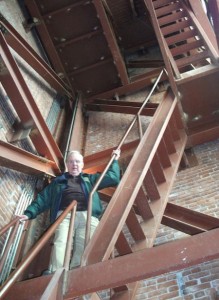Silverton resident Ruth Schneider was awakened to a “big roar.”
Mount Angel resident Susan Craig thought a freight train was crashing through her bedroom.
Both women have clear recollections of the earthquake on March 25, 1993.
“My grandson and I popped out of bed at the same time. We watched the walls. They looked like big ribbons.
All four of them were tilting into the rooms,” Schneider said.
Craig, a parishioner at St. Mary’s Church, remembers the church wall was in danger of collapsing because of cracks that separated one of the buttresses from the building.
Silverton Fire Captain Ed Grambusch said the 1993 earthquake was a “wakeup call” shaking the ground for 45 seconds from Roseburg to Seattle, with the epicenter three mills east of Scotts Mills.
For Grambusch and other responders, it was the start of a journey to prepare citizens for the next big quake that could hit any time. “We tend to get proactive after a disaster happens and strive to be ready for the next surprise,” he said.
Sign-up to be alerted by phone or
e-mail about emergencies at www.norcom911.org
Have one gallon of water per
person per day and food to
last at least 72 hours for your family.
For tips go to www.fema.gov/hazard/earthquake and
www.shakeout.org/centralus/resources/videos.html
Seventeen years after the 5.6-6.0 quake, the largest in the Pacific Northwest since the Elk Lake earthquake of 1981, the cities of Mount Angel and Silverton have comprehensive hazard preparedness plans that show how communities should operate in the event of an earthquake, severe weather or flooding.
“We work very closely with other districts, but we need to keep in mind that we should be able to take care of our own family and community first,” Mount Angel Fire Chief Don Fleck said.
Fleck and former Mount Angel Police Chief Brent Earhart collaborated in creating the Mount Angel plan, which few people have read.
“Getting the info out there has been the challenge. We’re maxed out just trying to keep up with training mandates. We need help to disseminate the information in the plan,” he said.
Fleck stressed family preparedness and mutual aid as the foundation of any community preparedness plan. He saw this principle in action during the 1985 oil spill in Mount Angel, when 600 homes were evacuated. “We only had one family in a shelter. Everybody else took in friends and relatives,” he recalled.
Fleck said it’s important to remember that the ’93 earthquake damaged utilities, roads and bridges throughout the region.
“Mount Angel lost part of the water supply from the ’93 earthquake. Pump #5, for instance, was pumping 500 gallons a minute. It’s been pumping 100 gallons a minute since the quake. It was a relatively small tremor, but this is what it did to the infrastructure. We may lose the ability to pump water in a bigger tremor and may have to consider rationing water,” he said.
A tremor as big as an 8 or 9 on the Richter scale in the area isn’t a remote possibility. According to the Oregon Department of Geology and Mineral Industries, the maximum magnitude of a Cascadia subduction zone earthquake, for both past and future events, is estimated to be about 8.5-9.0
Silverton building inspector Daryl Jones paints a picture of the Silverton or Mount Angel downtown scene after an 8 – 9 magnitude earthquake.
“The office building I’m in, just like most of the other buildings downtown, were not built to withstand such an earthquake. Most buildings will be reduced to rubble. We don’t make our buildings strong enough to withstand this kind of earthquake. We’re only trying to get people out after they duck, cover, and hold during the quake,” Jones said.
Only buildings built within the last 15 years have various levels of seismic preparedness, Jones said, adding
“It takes about six years for seismic safety upgrades to get into the building codes.”
Jones has trained 30 people to do damage assessment on homes after an earthquake, which is above and beyond the CERT (Citizens Emergency Response Teams) training. After an earthquake, these volunteers are certified to perform rapid damage assessments in residential and some commercial structures.
Grambusch stressed communication plays a key role in hazard management. “It would be good to have more ham radio operators involved when landline, cell phones, and Internet connection are down,” he said.
He also urged everyone to register for the Citizen Alert Notification system available to North Marion County residents. This emergency and non-emergency system provides residents with critical information quickly in a variety of situations, such as severe weather, unexpected road closures, missing persons, and evacuation of buildings or neighborhoods. Citizens can sign up by going to the NORCOM 911 website.
The Silverton Fire District is currently retrofitting the Scotts Mills station for seismic safety, has acquired a 500-gallon diesel generator, and improved its radio system. “If power is down, we can be functional,” Grambusch said.
Fleck explained that the police, fire district, public works, city hall and city councilors would work as a unified command in responding to a community hazard. This unified command follows the National Incident Management System (NIMS), which provides a systematic approach to guide all sectors of society to prevent, protect against, respond to, recover from, and mitigate the effects of incidents in order to reduce the loss of life, property, and harm to the environment.
NIMS is promulgated by the Federal Emergency Management Agency (FEMA), which is a division of Homeland Security. Fleck urged citizens to visit the FEMA website, which offers a wealth of information on hazard preparedness. “Go through the checklist for your home, school, church, or workplace. Take action, and check the boxes.”

